Themed collection Macrocycle-based Supramolecular Elements

Macrocycle-based supramolecular elements
Hai-Bo Yang and Christoph A. Schalley introduce this themed issue on macrocyle-based supramolecular elements.

Org. Chem. Front., 2021,8, 5606-5607
https://doi.org/10.1039/D1QO90079J
Macrocyclic and acyclic supramolecular elements for co-precipitation of square-planar gold(III) tetrahalide complexes
Non-covalent interactions control the solid-state packing of AuX4− anions (yellow circles) co-precipitated with different supramolecular elements.
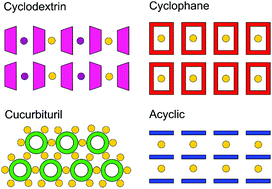
Org. Chem. Front., 2021,8, 1294-1301
https://doi.org/10.1039/D0QO01562H
Direct synthetic routes to functionalised crown ethers
Modification of crown ethers via grafting of functional groups represents a convenient yet underexplored tool.
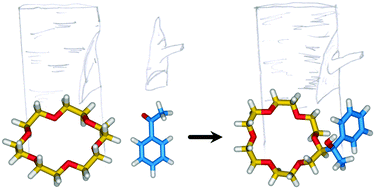
Org. Chem. Front., 2021,8, 5531-5549
https://doi.org/10.1039/D1QO00699A
Photoinduced host-to-guest electron transfer in a self-assembled coordination cage
Light–powered host–guest charge transfer (HGCT) is shown for a coordination cage based on electron-rich phenothiazines, containing an anthraquinone acceptor as guest. Transient absorption spectroscopy and spectroelectrochemistry data is presented.

Org. Chem. Front., 2022,9, 5485-5493
https://doi.org/10.1039/D2QO01339H
Bis-borylated arylisoquinoline-derived dyes with a central aromatic core: towards efficient fluorescent singlet-oxygen photosensitizers
Polycyclic aromatic hydrocarbon chromophores that show an ideal bipartition between fluorescence and singlet oxygen production have been developed.
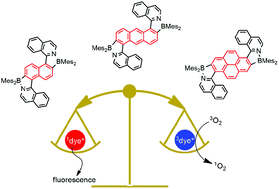
Org. Chem. Front., 2022,9, 4250-4259
https://doi.org/10.1039/D2QO00778A
Customized self-assembled molecules: rim adjustable coronal polygons with multiple-folds symmetry
Three desired discrete metallomacrocyclic wreaths with four-, five- and six-fold symmetry were successfully realized in a controlled fashion.
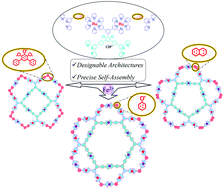
Org. Chem. Front., 2021,8, 5902-5909
https://doi.org/10.1039/D1QO01316E
Divergent synthesis of pyrrolidine and glutamic acid derivatives using a macrocyclic phase-transfer catalyst under high-pressure conditions
The reactivity of the glycine ketimine ester with α,β-unsaturated ketones in the presence of macrocyclic hybrid phase-transfer catalysts under high pressure conditions has been investigated.

Org. Chem. Front., 2021,8, 5888-5894
https://doi.org/10.1039/D1QO01198G
Allosteric binding of sodium deoxycholate by a bis(β-cyclodextrin)-2,2′-bipyridine receptor
The allosteric effect of a new bis(β-cyclodextrin) receptor amounts to a more than 18-fold increase of its binding affinity towards sodium deoxycholate upon addition of a zinc(II) phenanthroline complex as an effector.
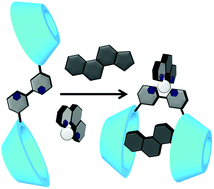
Org. Chem. Front., 2021,8, 5810-5820
https://doi.org/10.1039/D1QO01173A
Naphthobox: a selective molecular box for planar aromatic cations
A molecular box with an electron-rich cavity, namely naphthobox, was contructed and showed selective binding to planar aromatic cations.
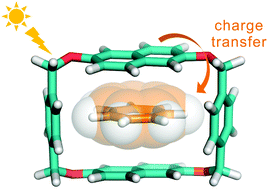
Org. Chem. Front., 2021,8, 5265-5270
https://doi.org/10.1039/D1QO00819F
A supramolecular dual-donor artificial light-harvesting system with efficient visible light-harvesting capacity
A supramolecular dual-donor artificial light-harvesting system with efficient visible light-harvesting capacity was constructed through the hierarchical self-assembly approach.
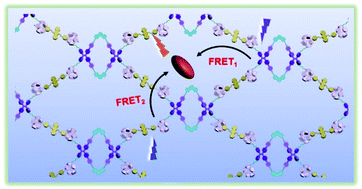
Org. Chem. Front., 2021,8, 5250-5257
https://doi.org/10.1039/D1QO00771H
Switchable supramolecular ensemble for anion binding with ditopic hydrogen-bonded macrocycles
A novel supramolecular strategy has been proposed by using a ditopic H-bonded amide macrocycle that is capable of controlling the binding process in response to external stimulus due to its assembly-and-disassembly-induced anion binding.
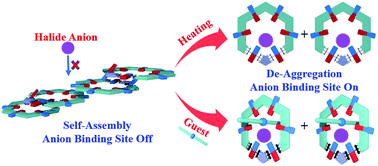
Org. Chem. Front., 2021,8, 5271-5279
https://doi.org/10.1039/D1QO00764E
Efficient one-pot synthesis of [3]catenanes based on Pt(II) metallacycles with a flexible building block
Three [3]catenanes were fabricated in high efficiency through the self-assembly of a 90° platinum(II) receptor, a flexible bis(4,4′-bipyridinium) donor and a crown ether (DB24C8 or DB30C10).
![Graphical abstract: Efficient one-pot synthesis of [3]catenanes based on Pt(ii) metallacycles with a flexible building block](/en/Image/Get?imageInfo.ImageType=GA&imageInfo.ImageIdentifier.ManuscriptID=D1QO00910A&imageInfo.ImageIdentifier.Year=2021)
Org. Chem. Front., 2021,8, 5280-5288
https://doi.org/10.1039/D1QO00910A
Imino-thiolate-templated synthesis of a chloride-selective neutral macrocyclic host with a specific “turn-off–on” fluorescence response for hypochlorite (ClO−)
A precise replacement of one oxygen atom with sulfur allowed a novel thioimidate anion-templated macrocyclization to form a crowded host 2 with the ability to act as a highly selective and sensitive fluorescence probe for hypochlorite (ClO−).
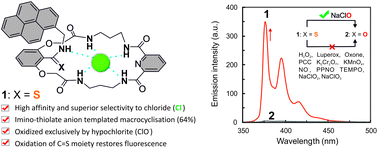
Org. Chem. Front., 2021,8, 5258-5264
https://doi.org/10.1039/D1QO00504A
Synthesis, structure elucidation and functionalization of sulfonamide [2]catenanes
A pyrene-functionalized [2]catenane with switchable optical output was constructed through a novel sulfonamide [2]catenane synthesized by a self-templation approach.
![Graphical abstract: Synthesis, structure elucidation and functionalization of sulfonamide [2]catenanes](/en/Image/Get?imageInfo.ImageType=GA&imageInfo.ImageIdentifier.ManuscriptID=D1QO00691F&imageInfo.ImageIdentifier.Year=2021)
Org. Chem. Front., 2021,8, 4994-5001
https://doi.org/10.1039/D1QO00691F
Expanded all-phenylene molecular spoked wheels: cutouts of graphenylene-3
All-phenylene molecular spoked wheels, cutouts of graphenylene-3, have been synthesized by intramolecular Yamamoto coupling of the respective dodecabromides.
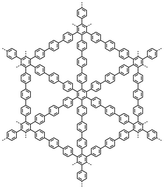
Org. Chem. Front., 2021,8, 4980-4985
https://doi.org/10.1039/D1QO00876E
Chiral supramolecular polymerization of dicyanostilbenes with emergent circularly polarized luminescence behavior
A novel type of circularly polarized luminescence (CPL) active systems have been constructed via chiral supramolecular polymerization of dicyanostilbene-based monomers.
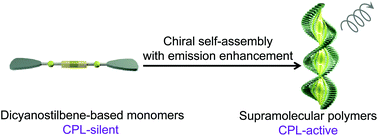
Org. Chem. Front., 2021,8, 4986-4993
https://doi.org/10.1039/D1QO00756D
A multi-responsive supramolecular heparin-based biohybrid metallogel constructed by controlled self-assembly based on metal–ligand, host–guest and electrostatic interactions
A new family of supramolecular heparin-based biohybrid metallogels with multiple stimuli-responsive behaviours was constructed through the controlled self-assembly based on three orthogonal interactions within a single system.

Org. Chem. Front., 2021,8, 4715-4722
https://doi.org/10.1039/D1QO00692D
Truxene-based covalent organic polyhedrons constructed through alkyne metathesis
Dynamic alkyne metathesis has successfully been employed toward the synthesis of a truxene-based shape-persistent covalent organic polyhedron (COP) with high binding affinity for fullerenes.
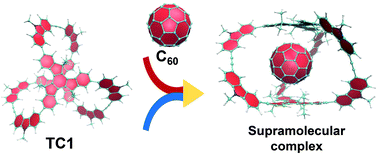
Org. Chem. Front., 2021,8, 4723-4729
https://doi.org/10.1039/D1QO00685A
Aryl carbazole-based macrocycles: synthesis, their remarkably stable radical cations and host–guest complexation with fullerenes
Herein, we have designed and synthesized a series of aryl carbazole-based macrocycles and their stable radical cation species and interesting fullerene recognition were systematically investigated.

Org. Chem. Front., 2021,8, 4678-4684
https://doi.org/10.1039/D1QO00686J
Functional group introduction and aromatic unit variation in a set of π-conjugated macrocycles: revealing the central role of local and global aromaticity
Insights into how the optoelectronic properties of π-conjugated macrocycles evolve as a result of systematic structural changes are presented, helping to develop structure–property relationships and molecular design guidelines.
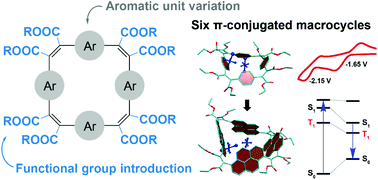
Org. Chem. Front., 2021,8, 4730-4745
https://doi.org/10.1039/D1QO00901J
Aqueous assembly of a (pseudo)rotaxane with a donor–π–acceptor axis formed by a Knoevenagel condensation
The incorporation of a linear D–π–A “push–pull” chromophore synthesized by a Knoevenagel condensation as axle of a rotaxane is reported.
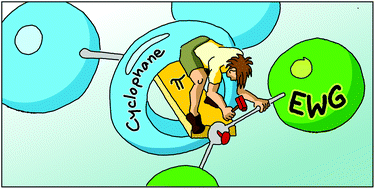
Org. Chem. Front., 2021,8, 4399-4407
https://doi.org/10.1039/D1QO00643F
Perylene bisimide cyclophanes as receptors for planar transition structures – catalysis of stereoinversions by shape-complementarity and noncovalent π–π interactions
Perylene bisimide cyclophanes, ideal receptors for planar aromatic compounds, act as π–π catalysts by stabilizing shape-complementary stereoinversion transition structures.
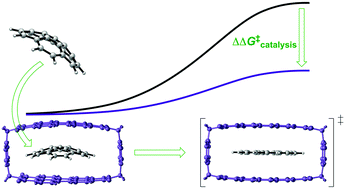
Org. Chem. Front., 2021,8, 4408-4418
https://doi.org/10.1039/D1QO00755F
Site-selective binding of terpenoids within a confined space of metal–macrocycle framework: substrate-specific promotion or inhibition of cyclization reactions
Terpenoids, (S)-citronellal, nerol, geraniol and farnesol, were site-selectively adsorbed to binding pockets on the pore surface of a metal-macrocycle framework, and their cyclization reaction was controlled in a confined nanospace.
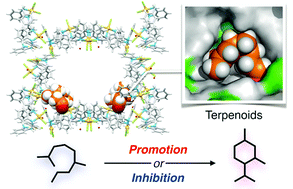
Org. Chem. Front., 2021,8, 4071-4077
https://doi.org/10.1039/D1QO00750E
Straightforward supramolecular purification of C84 from a fullerene extract
An efficient, one-step protocol for the enrichment of C84 (up to 86%) directly from a fullerene extract is reported, by utilizing a tetragonal prismatic nanocapsule with a suitable size and shape for selective encapsulation.
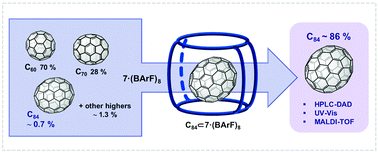
Org. Chem. Front., 2021,8, 4101-4105
https://doi.org/10.1039/D1QO00597A
Triazolate-based pillarplexes: shape-adaptive metallocavitands via rim modification of macrocyclic ligands
Rim-modified pillarplexes are prepared by a macrocycle-templated synthesis strategy. They exhibit a shape-adaptive behaviour and complementary H-bonding, showing that rim modification can modulate the flexibility and functionality of the cavitand.
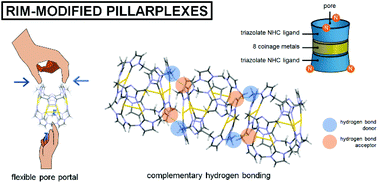
Org. Chem. Front., 2021,8, 4061-4070
https://doi.org/10.1039/D1QO00588J
Cucurbitimines – imine cages with concave walls
Kinked tetraaldehyde building blocks lead in condensation reactions with diamines to pumpkin shaped cages – the cucurbitimines.

Org. Chem. Front., 2021,8, 3668-3674
https://doi.org/10.1039/D1QO00478F
Coordination-driven assembly of actinide-organic polyrotaxanes involving crown ether macrocycles
Using macrocyclic DB24C8 as a new kind of host molecule for a pseudorotaxane ligand, actinide-linked crown ether-based coordination polyrotaxanes, UCER-1 and UCER-2, that are linked by two different uranyl nodes, have been synthesised for the first time.
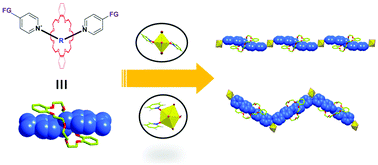
Org. Chem. Front., 2021,8, 3686-3694
https://doi.org/10.1039/D1QO00536G
Self-division of 2-D sheets in aromatic macrocycle assembly
2-D Sheets from macrocycle assembly undergoes reversible lengthwise division in response to temperature change.
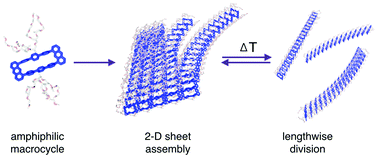
Org. Chem. Front., 2021,8, 3681-3685
https://doi.org/10.1039/D1QO00440A
Pillar[5]arene-based ion-pair recognition for constructing a [2]pseudorotaxane with supramolecular interaction induced LCST behavior
Here, we report a novel [2]pseudorotaxane based on perbromoethylated pillar[5]arene/imidazolium iodide ionic liquid ion-pair recognition and this pseudorotaxane shows supramolecular interaction induced LCST behavior in solution.
![Graphical abstract: Pillar[5]arene-based ion-pair recognition for constructing a [2]pseudorotaxane with supramolecular interaction induced LCST behavior](/en/Image/Get?imageInfo.ImageType=GA&imageInfo.ImageIdentifier.ManuscriptID=D1QO00457C&imageInfo.ImageIdentifier.Year=2021)
Org. Chem. Front., 2021,8, 3675-3680
https://doi.org/10.1039/D1QO00457C
Dual-stimuli pseudorotaxane switches under kinetic control
Dual-stimuli pseudorotaxane switches: Threaded complexes dissociate upon deprotonation or oxidation. A mechanical bond changes the influence of a ‘speed bump’ on the outcome of a switching event.

Org. Chem. Front., 2021,8, 3659-3667
https://doi.org/10.1039/D1QO00503K
Clover leaf-shaped supramolecules assembled using a predesigned metallo-organic ligand
A series of clover-like supramolecular structures were designed and synthesized using a combination of Ru–Zn, Ru–Co, Ru–Mn or Ru–Ni metal ions. These structures with distinct redox properties may have further applications as functional materials.

Org. Chem. Front., 2021,8, 3244-3249
https://doi.org/10.1039/D1QO00336D
Self-assembled luminescent Cu(I) tetranuclear metallacycles based on 3,3′-bipyridine ligands
Three luminescent tetranuclear macrocycles are obtained selectively, applying coordination-driven supramolecular processes to the reaction of 3,3′-bipyridine ligand with in situ formed Cu(I) bimetallic units bearing a coordination angle of ca. 120°.
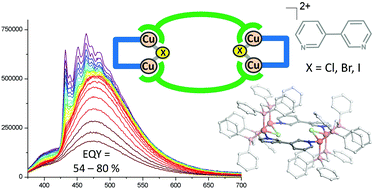
Org. Chem. Front., 2021,8, 2893-2902
https://doi.org/10.1039/D1QO00538C
Supramolecular fluorescence sensing of L-proline and L-pipecolic acid
Fluorescent mono-phosphonate calix[4]pyrrole cavitands display selectivity in amino acids' sensing.
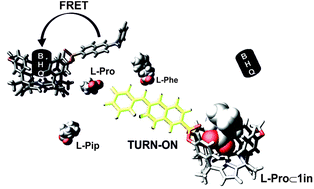
Org. Chem. Front., 2021,8, 2402-2412
https://doi.org/10.1039/D1QO00517K
Selective formation of spiroborate-based double-stranded hetero-helicates assisted by donor–acceptor interactions
A novel spiroborate-based double-stranded hetero-helicate is selectively formed through donor–acceptor interactions between the central electron-rich porphyrin and electron-deficient naphthalene diimide units.
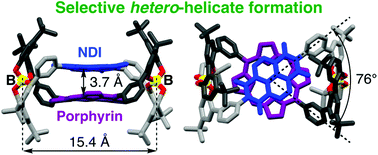
Org. Chem. Front., 2021,8, 2551-2555
https://doi.org/10.1039/D1QO00286D
Dinuclear helicate or mononuclear pincer lanthanide complexes from one ligand: stereo-controlled assembly and catalysis
By varying the metal/ligand ratio, either dinuclear triple helicate or mononuclear pincer can be stereo-selectively obtained from the same chiral ligand. Their catalytic properties have been demonstrated with the asymmetric FC alkylation reactions.

Org. Chem. Front., 2021,8, 2576-2582
https://doi.org/10.1039/D1QO00369K
Sodium cation-templated synthesis of an ion-pair binding heteroditopic [2]catenane
A novel method utilising sodium cation templation between a pyridinium bridged calix[4]diquinone macrocycle and a pyridine-N-oxide functionalised macrocycle precursor motif is used for the construction of a mechanically interlocked ion-pair.
![Graphical abstract: Sodium cation-templated synthesis of an ion-pair binding heteroditopic [2]catenane](/en/Image/Get?imageInfo.ImageType=GA&imageInfo.ImageIdentifier.ManuscriptID=D1QO00247C&imageInfo.ImageIdentifier.Year=2021)
Org. Chem. Front., 2021,8, 2468-2472
https://doi.org/10.1039/D1QO00247C
Synthetic platform for mono-functionalised tridentate macrocycles as key precursors of mechanically-linked macromolecular systems
Macrocycles bearing a variety of functional groups give access to a wide range of synthetic methods for further derivatisation or preparation of more complex structures such as mechanically interlocked molecules or polymeric materials.
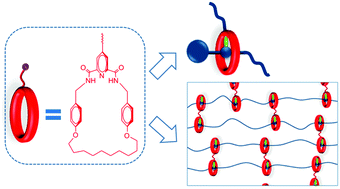
Org. Chem. Front., 2021,8, 2383-2392
https://doi.org/10.1039/D1QO00245G
Dynamics of mechanically bonded macrocycles in radial hetero[4]catenane isomers
A pair of radial [4]catenane isomers interlocked with two CB[6]s and one β-CD is reported. Due to the different positions of the tightly bound CB[6]s, shuttling dynamics of the β-CD between the two biphenyl stations are different in the isomers.
![Graphical abstract: Dynamics of mechanically bonded macrocycles in radial hetero[4]catenane isomers](/en/Image/Get?imageInfo.ImageType=GA&imageInfo.ImageIdentifier.ManuscriptID=D0QO01658F&imageInfo.ImageIdentifier.Year=2021)
Org. Chem. Front., 2021,8, 2182-2189
https://doi.org/10.1039/D0QO01658F
Reversible fluorescence modulation through the photoisomerization of an azobenzene-bridged perylene bisimide cyclophane
An azobenzene-bridged perylene bisimide cyclophane was designed and synthesized, which showed reversible fluorescence intensity switching under light-irradiation due to cooperative adjustments of PBI–PBI and PBI–Azo interactions.

Org. Chem. Front., 2021,8, 1424-1430
https://doi.org/10.1039/D0QO01635G
Diverse binding of cationic guests by highly substituted [3 + 3] Schiff-base macrocycles
Schiff-base macrocycles interact with ammonium-based guests to form threaded pseudorotaxanes or unthreaded external complexes, and tautomerize in the process.
![Graphical abstract: Diverse binding of cationic guests by highly substituted [3 + 3] Schiff-base macrocycles](/en/Image/Get?imageInfo.ImageType=GA&imageInfo.ImageIdentifier.ManuscriptID=D0QO01568G&imageInfo.ImageIdentifier.Year=2021)
Org. Chem. Front., 2021,8, 1437-1446
https://doi.org/10.1039/D0QO01568G
Template-driven construction of [8]-imidazolium macrocycles
A controllable and efficient template-driven strategy for the rational construction of polyimidazolium macrocycles has been developed.
![Graphical abstract: Template-driven construction of [8]-imidazolium macrocycles](/en/Image/Get?imageInfo.ImageType=GA&imageInfo.ImageIdentifier.ManuscriptID=D0QO01617A&imageInfo.ImageIdentifier.Year=2021)
Org. Chem. Front., 2021,8, 1431-1436
https://doi.org/10.1039/D0QO01617A
A self-assembled tetrathiafulvalene box
A M8L2 metalla-cage constructed through coordination-driven self-assembly from a quinonato bis-ruthenium complex and an electron-rich tetrathiafulvalene (TTF) tetrapyridyl ligand is depicted.
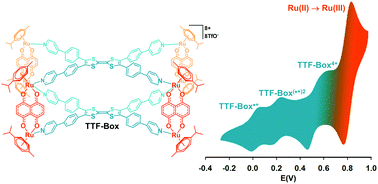
Org. Chem. Front., 2021,8, 883-890
https://doi.org/10.1039/D0QO01543A
Exploring the tubular self-assembly landscape of dinucleobase amphiphiles in water
The tubular aqueous assembly of dinucleobase amphiphilic monomers endowed with anionic, neutral or cationic groups is investigated under diverse conditions.
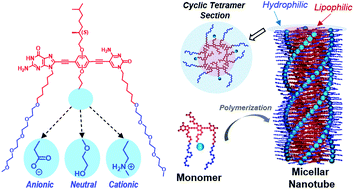
Org. Chem. Front., 2021,8, 686-696
https://doi.org/10.1039/D0QO01110J
Orientation of the α-CD component of [2]rotaxanes affects their specific molecular recognition behaviour
An α-CD component enhanced the anion recognition ability of the urea moiety and the deprotonation of the phenol moiety in the axle component in orientationally isomeric [2]rotaxanes with the OH groups on the wide rim of the α-CD, respectively.
![Graphical abstract: Orientation of the α-CD component of [2]rotaxanes affects their specific molecular recognition behaviour](/en/Image/Get?imageInfo.ImageType=GA&imageInfo.ImageIdentifier.ManuscriptID=D0QO01337D&imageInfo.ImageIdentifier.Year=2021)
Org. Chem. Front., 2021,8, 676-685
https://doi.org/10.1039/D0QO01337D
Construction of organometallic trefoil knots and one-dimensional chains featuring half-sandwich Cp*Rh corner units and an abnormal zwitterion ligand
An abnormal flexible O-coordinated zwitterion ligand L shows self-adaptive conformation behaviour in chemical self-assembly. Two trefoil knots were obtained with C-shaped ligand L and two novel 1D chains were obtained with Z-shaped ligand L.
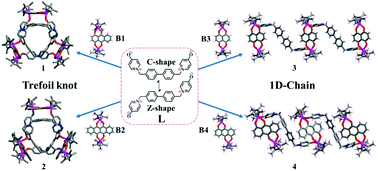
Org. Chem. Front., 2021,8, 231-238
https://doi.org/10.1039/D0QO01279C
Cucurbituril-assisted formation of tunable carbon dots from single organic precursors in water
A facile method by utilizing the host–guest interaction of Q[n]s for the catalytic fabrication of CDs with high emitting qualities and a tunable particle size from a single organic precursor in water with high output has been demonstrated.

Org. Chem. Front., 2021,8, 224-230
https://doi.org/10.1039/D0QO01143F